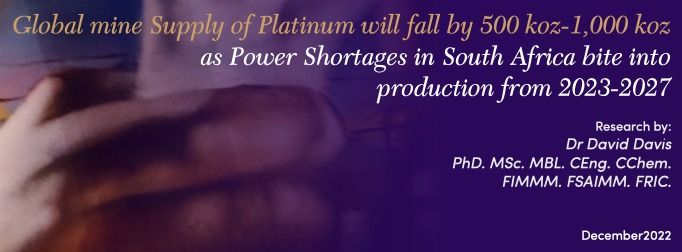Global mine Supply of Platinum will fall by 500koz-1,000koz
as Power Shortages in South Africa bite into production from 2023-2027
Dr David Davis, December 2022
Research analysts tend to concentrate on global demand curves for Platinum as well as new applications that are driving demand, hence predicted forward demand numbers versus global supply and in-ground inventories etc.
What many mainstream research houses and analysts seem to be ignoring outright, is the all-important supply curves. Whilst they do to some extent account for ore-grade degradation, they fail to take into consideration the increasing pressures on supply. As a result the vast majority of analysts are completely missing the significant impact of the huge fall in production and resultant supply over the last 12 months and what this means moving forwards in their modeling.
We specialise in closely assessing both sides of the supply/demand equation in order to exact a considerably more accurate picture of where the price of Platinum (in particular) is headed; price acts as the mechanism of final arbiter, price eventually forces the balance in the growing supply/demand imbalances (in this case deficits of platinum supply) over this immediate cycle and into the end of the decade.
The Platinum market has had a wild ride over the last two years, experiencing a big fall in price below US$600/oz in March 2020 as the global pandemic negatively impacted all global asset classes, immediately followed by an enormous rally to US$1,340/oz in February of 2021. This stellar move was driven off the back of a reported global supply/demand deficit.
Soon thereafter, the world’s major research groups began to report global Platimum surpluses in 2022 which unduly affected the price. These reports and data sets have since been retracted (although the investment market continues to ignore this at present), as they initially refused to include China’s very large import data from their headline numbers.
Why did they choose to do this you may ask?
Considering China is one of the largest global importers of Platinum, China only imports Platinum and does not export Platinum. Research agency excuses for this misdirection (particularly on headline news) was centred around the fact that they could not cross China’s borders due to lockdowns to ascertain the usage of China’s imports and therefore simply omitted China’s physical imports from the entire global supply/demand data – quite bizarre and misleading indeed!
In 2021, China’s Platinum imports reached 85.44 tons, up 45.21% year-on-year, with an import value of US$3.116 billion, up 83.86% in US$ terms year-on-year. From January to October 2022, China imported 62.13 tons of Platinum. We will know more accurate data for the full year of 2022 in a few months from now and are expecting their overall imports of Platinum to be considerable and clearly pushing the world into deficit.
The demand for Platinum is highest in the field of automotive catalysts, and the rapid development of the Chinese automotive industry as a result of ever more stringent pollution controls over the last decade in particular. This has taken place alongside a very well documented move into Hydrogen production and usage, which has contributed to the overall growth of Platinum consumption in China. China needs to import a considerable amount of Platinum every year as their reserves remain very low.
This report by Dr David Davis focuses on the future quantum of global PGMs and Platinum mine supply together with the heightening risks associated with their supply. Note that South Africa, Russia and Zimbabwe represent around 73%, 10% and 8% of global Platinum supply, respectively. In this regard, it is immediately obvious that circa. 91% of the world’s Platinum supply comes from just three countries. This geographical and political concentration of supply can be described as ‘precarious’ at best. It is noted that global mining is not without risk. However, PGM and Platinum mine production faces additional existential risks and I refer to these “additional existential risks” in this report. For South Africa, one of the many additional existential risks is the looming and potentially catastrophic energy crisis.
CLICK HERE to download the full report
Protect your wealth; invest in physical gold, silver or other precious metals at best prices from Indigo Precious Metals. Physical delivery across the world.
Consider the safest option of segregated, allocated vault storage at Le Freeport Singapore with Indigo Precious Metals.
Disclaimer : The information contained in this website should be used as general information only. It does not take into account the particular circumstances, investment objectives and needs for investment of any investor, or purport to be comprehensive or constitute investment advice and should not be relied upon as such. You should consult a financial adviser to help you form your own opinion of the information, and on whether the information is suitable for your individual needs and aims as an investor. You should consult appropriate professional advisers on any legal, taxation and accounting implications before making an investment.

